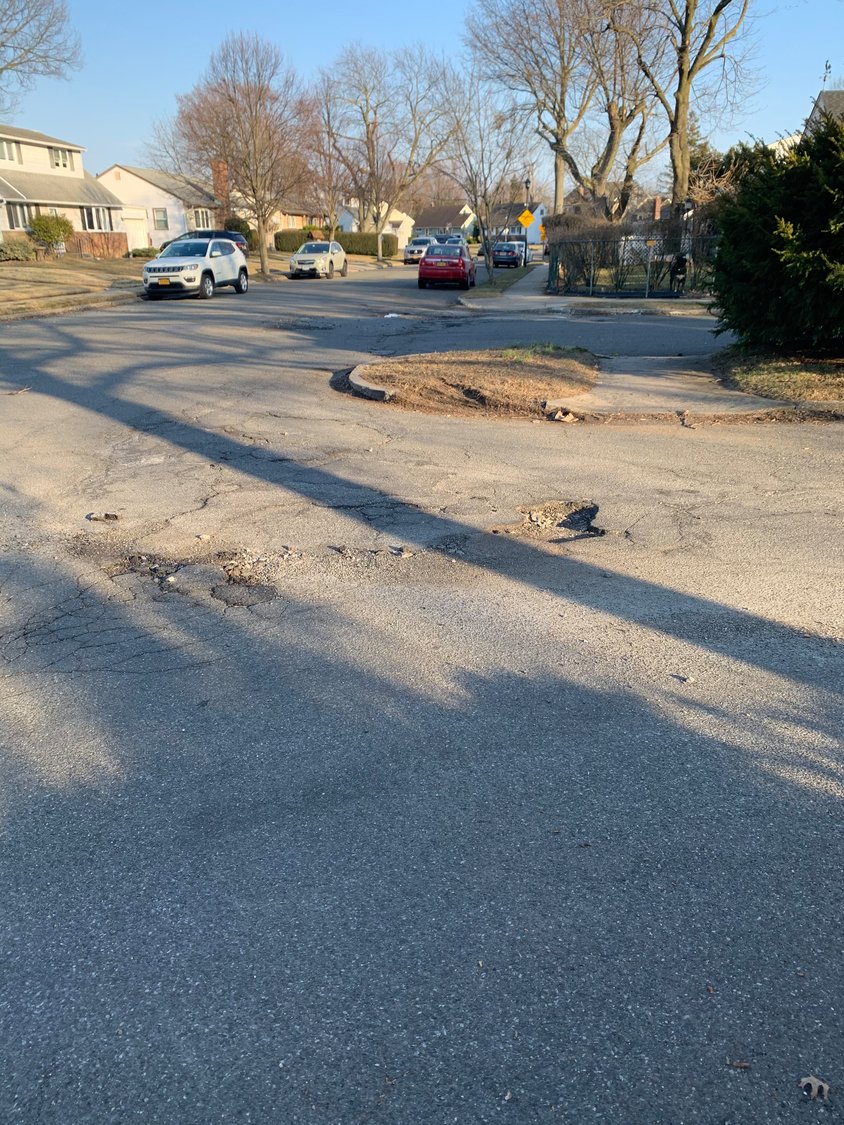Thursday, April 18, 2024
Pothole season is here again
Residents concerned about road conditions in Wantagh, Seaford
The signs of the end of winter and the beginning of spring are unmistakable: warmer weather, later sunsets, birds chirping and, of course, potholes.
As he walked his dog on March 10, Wantagh resident Billy Rahner noticed a pile of asphalt beside the sidewalk, along with shallow cracks and holes, at the corner of Northview and Centerview Avenue.
“Any time I go to leave to go out to Jerusalem Avenue and I have to make a left, I have to avoid two huge potholes,” said Rahner, who has lived in Wantagh since 2004. “It’s like going through an obstacle course.”
Most potholes form in the winter, when water seeps inside the surface foundation of roads and freezes, pushing the pavement upward. When the temperature rises, the ice melts, creating a hollow space between the pavement and the sub-base. The empty space weakens the pavement, making it more likely that a pothole will form.
Wantagh and Seaford residents say that the potholes are a danger to children riding bikes, commuters on their way to work and even dog owners, whose pets have been known to try to take pieces of asphalt with them.
The areas that residents noted are of particular concern include the Wantagh Avenue entrance to the Southern State Parkway, in Wantagh; Seamans Neck Road, in Seaford; the beginning of Edgerton Avenue, off Wantagh Avenue, in Wantagh; Park Avenue, in Seaford; Wantagh Oaks Gate; and the corner of Campbell Road and Anita Lane, in Wantagh.
“The streets have cracks, and because of the way they plow out here, they plow all the snow to the corners, and now that all the snow melted, that’s what every corner looks like,” Rahner said. “These huge chunks of asphalt are on the corners, and now, as the homeowners, what are you supposed to do?”
Rahner said he supposed homeowners could sweep it up and toss it in the garbage. “But they won’t pick it up because the pail is too heavy,” he said. “I’m paying $12,000 a year in taxes — I shouldn’t have to worry about cracking my ankle in the street when I walk my dog.”
Greg Blower, director of communications for the Town of Hempstead, said that as the country’s largest township, over 1,200 miles of roadways fall under its jurisdiction. “Our pothole response crews, led by our Highway Department, are working on the roads daily, filling at a rate of about 1,000 potholes a day,” Blower said. “Just last week our crews repaired over 4,400 potholes across the town. Since January, we’ve utilized over 247 tons of asphalt just on pothole repair.”
Blower added that the town took a proactive approach by sending teams into its various communities to map out areas that needed repair, and deploying the Parks Department to assist highway crews.
But some residents aren’t satisfied with the town’s response in recent years. “We’ve written several times and it’s never been addressed,” said Jen O’doherty, Rahner’s neighbor. “Finally, about two weeks ago, I wrote to the town about my concern, because now we’re dog owners and we notice things more.”
O’Doherty wrote to the town that dogs in the neighborhood were treating pieces of asphalt like free dog toys, and that observation appeared to elicit a response. “They came over and they did a little patch job on the foot of our driveway, but all throughout the neighborhood … there’s major potholes,” O’doherty said. “There’s one on the corner, by Southview Avenue and Wantagh Oaks Gate … it’s all kinds of ripped up.
I just feel as though [potholes] are a safety issue, a quality-of-life issue,” she said. “We pay an extraordinary amount of taxes to be here, and to see this get worse every year — the streets are becoming more of an eyesore.”
HELP SUPPORT LOCAL JOURNALISM
The worldwide pandemic has threatened many of the businesses you rely on every day, but don’t let it take away your source for local news. Now more than ever, we need your help to ensure nothing but the best in hyperlocal community journalism comes straight to you. Consider supporting the Herald with a small donation. It can be a one-time, or a monthly contribution, to help ensure we’re here through this crisis. To donate or for more information, click here.
Sponsored content
Other items that may interest you






